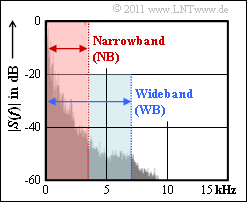Difference between revisions of "Aufgaben:Exercise 3.4: Different Voice Codecs"
From LNTwww
| Line 23: | Line 23: | ||
UMTS]]. | UMTS]]. | ||
*The graph shows the magnitude spectrum of an audio signal and defines the characteristics ''narrowband'' and ''wideband''. | *The graph shows the magnitude spectrum of an audio signal and defines the characteristics ''narrowband'' and ''wideband''. | ||
| − | *We refer you to the interactive applet [[Applets:Sprachcodecs|Qualität verschiedener Sprachcodecs]] | + | *We refer you to the interactive applet [[Applets:Sprachcodecs|Qualität verschiedener Sprachcodecs]]. |
Revision as of 20:15, 28 June 2020
The development of the GSM standard after 1990 was accompanied by the standardization of various voice codecs:
- With the first full-rate codec (FR) from 1991 a reduction to the data rate $13 \ \rm kbit/s$ was achieved, sufficiently low to be able to transmit a voice signal over a single traffic channel.
- In 1994 the Half-Rate Codec (HR) with the bitrate $5.6 \ \rm kbit/s$ was developed with the aim of being able to transmit two calls simultaneously in one traffic channel if required. However, the quality does not quite reach the full-rate codec.
- The Enhanced Full-Rate Codec ('EFR) from 1995 represented a significant development based on the data reduction method ACELP (Algebraic Code Excited Linear Prediction). The EFR codec delivers a data rate of $12.2 \ \rm kbit/s$ and stands for the common quality standard in mobile communications nowadays.
- In 1999, ETSI standardized the Adaptive Multi-Rate Codec (AMR) for GSM. This provides eight different modes with data rates between $4.75 \ \ \rm kbit/s$ and $12.2 \ \ \rm kbit/s$ . The AMR codec uses the ACELP method like the EFR codec.
- The Wideband AMR (WB-AMR) is a further development of the original AMR. It was standardized by the 3GPP consortium in 2001 and by ITU-T in 2002 and uses the frequency range from $50 \ \rm Hz$ to $7 \rm kHz$. This is therefore based on a "WideBand signal".
Notes:
- This exercise refers to Gemeinsamkeiten von GSM und UMTS.
- The graph shows the magnitude spectrum of an audio signal and defines the characteristics narrowband and wideband.
- We refer you to the interactive applet Qualität verschiedener Sprachcodecs.
Questionnaire
Sample Solution
(1) Correct are the solution suggestions 1 and 3:
- The required data rate is reduced by removing redundancy and irrelevance from the data signal
- The artificial word „Codec” indicates that the same functional unit is used for both encoding and decoding.
(2) Correct are the answers 2 and 3:
- The EFR–Codec from 1995 is a significant development of the Full–Rate Codecs from 1991, whereby, among other things, speech quality is less affected by background noise.
- Like the AMR, the EFR–Codec is based on the data reduction method ACELP (Algebraic Code Excited Linear Prediction).
- The first proposed solution is wrong. Like the FR and AMR codecs, the EFR codec is only designed for the telephone channel (300 Hz to 3.4 kHz).
- For better intelligibility and to avoid a dull sound, there is also a mid-range boost and a low-frequency cut.
(3) Only the solution 2 is correct:
- The advantage of the AMR–codec over the EFR is its greater flexibility.
- If the channel quality deteriorates significantly, it is possible to switch smoothly to a low-rate mode where transmission errors are less disturbing.
- In addition, as with the Half&ndash Rate Codec, it is possible to have two conversations in one traffic channel.
- The highest mode at 12.2 kbit/s - and not the lowest - is identical to the EFR codec. It is therefore obvious that AMR cannot provide better voice quality than EFR.
(4) All answers are correct:
- Nine modes are provided in wideband–AMR, but only five of them are used for mobile communications, namely those with data rates of 6.60, 8.85, 12.65, 15.85 and 23.65 kbit/s.
- The modes up to 12.65 kbit/s have the advantage that a voice signal encoded in this way can be accommodated in a single GSM–traffic channel. For the higher rate modes, GSM/EDGE or UMTS is required.
- The higher rate modes (15.85 and 23.65 kbit/s) provide only a slight improvement for speech, but due to the larger frequency range, they provide a noticeable improvement for the transmission of music.
- Both the WB-AMR 12.65 and the higher modes of (narrowband) AMR show weaknesses here. An even lower data rate gives extremely poor results with music signals.
- The WB-AMR has a better voice quality than the NB-AMR with 12.2 kbit/s even at a comparable data rate (12.65 kbit/s). Due to the greater bandwidth, speech sounds more natural and sibilants such as "s", "f" and "sch" become more intelligible.
